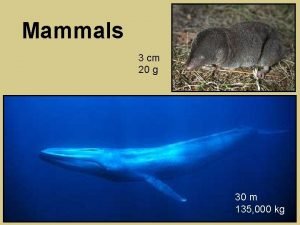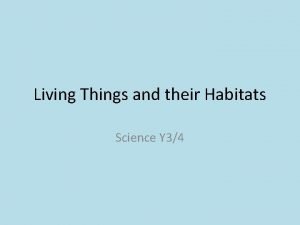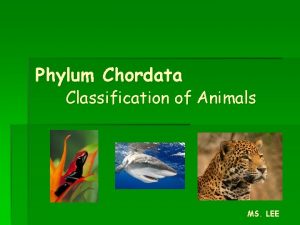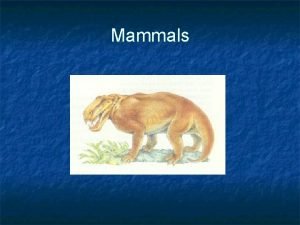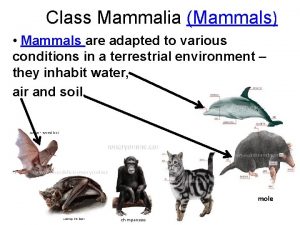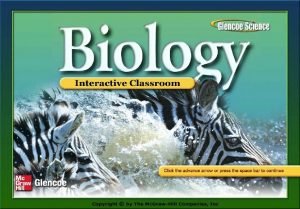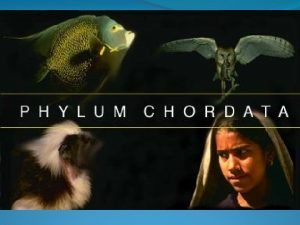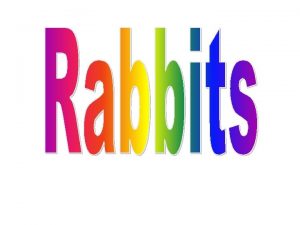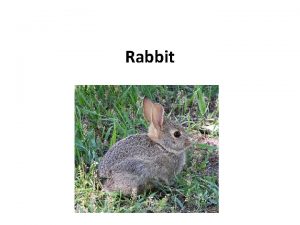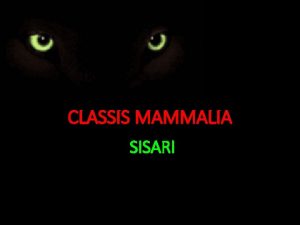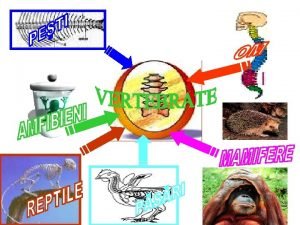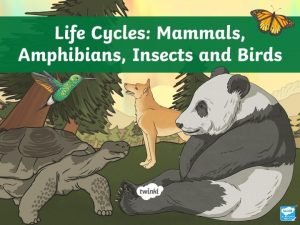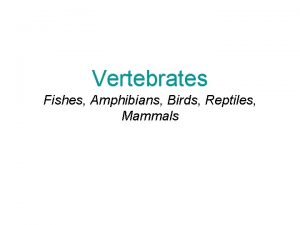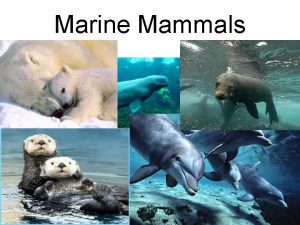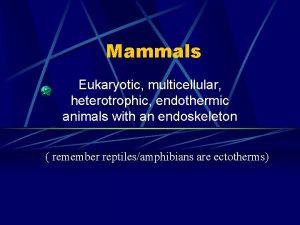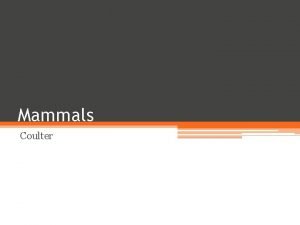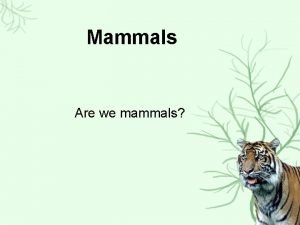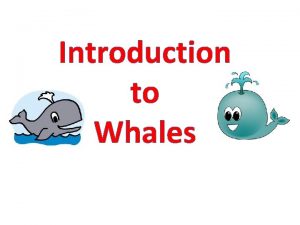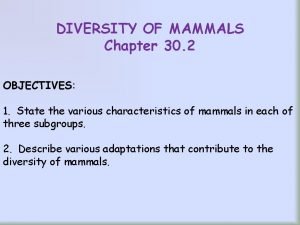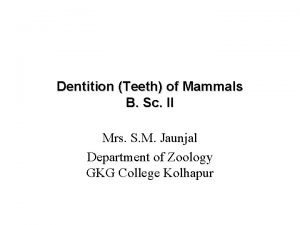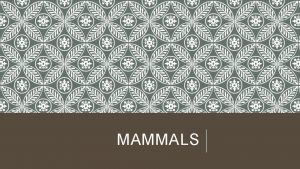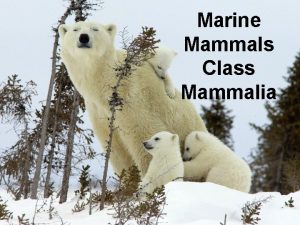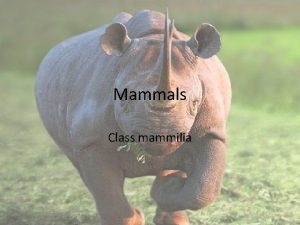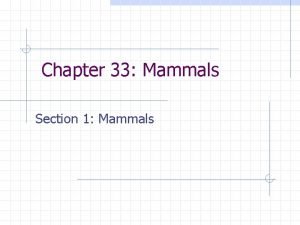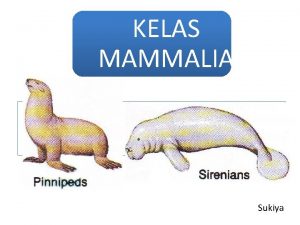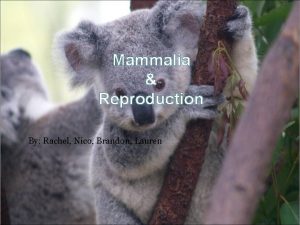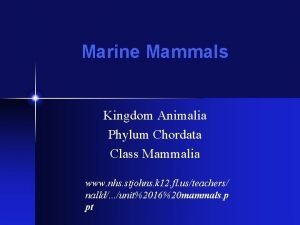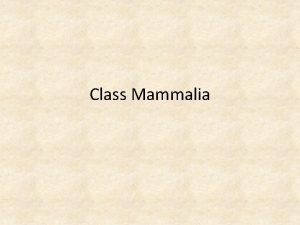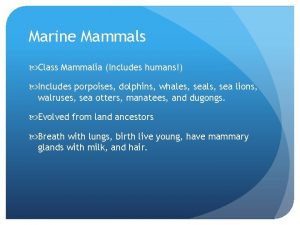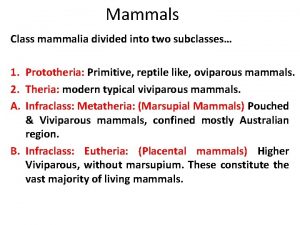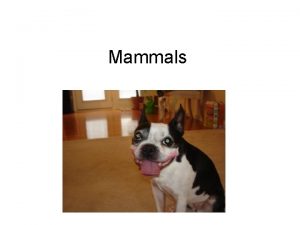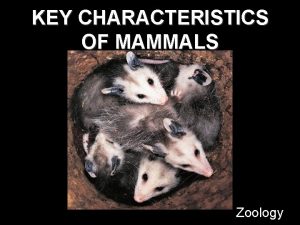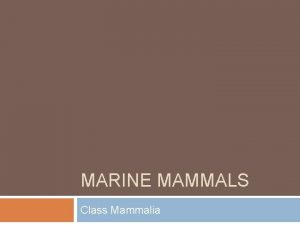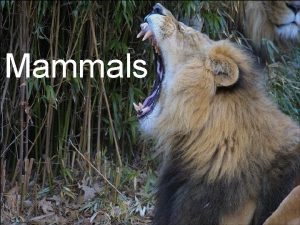Class Mammalia First mammals were small with delicate






























- Slides: 30

Class Mammalia

• First mammals were small with delicate skeletons, acute senses, and possibly nocturnal. – Avoid competition with larger organisms

Mammalian Characteristics • Hair or fur (pelage) – Keratin – Periodically molted – Insulating – Important to sense/touch – Most have claws, nails, or hooves

Mammalian Characteristics • Glands – Sebaceous: oil • Lubricates/waterproofs the hair/skin – Sudoriferous: sweat • evaporative/cooling – Scent or musk • Release pheromones • Involved in defense, species/sex recognition, and territorial behavior – Mammary (functional in females only) • Monotremes: no nipples, just depressions

Mammalian Characteristics • Skulls and teeth – Single articulation of the jaw bone – More extensive secondary palate (can chew and breathe) – Specialized teeth • Most have two sets (deciduous and permanent) • Types of teeth based upon diet

Mammalian Characteristics • Skeleton and muscles – Most have 7 cervical vertebrae (including giraffes!) • Manatees (6), tree sloths (6 or 9). – Trunk is divided into thoracic and abdominal cavities by diaphragm – Skeleton bears the body weight.

Mammalian Characteristics • Nutrition and Digestion • Specialized to diet – Cecum: fermentation pouch at the junction of large/small intestine • Herbivores (horses, rabbits, and rodents)…aids in the digestion of cellulose. – Ruminants: four chambers in stomach • First three are for storage and fermentation • Sheep, cattle and deer

Mammalian Characteristics • Circulation and Gas Exchange – Four chambered heart – Circulation between mother/fetus: placental • No blood is exchanged, just diffusion of nutrients, gases and wastes. – High metabolic rates require adaptations for efficient gas exchange • Efficient lungs, muscular diaphragm

Mammalian Characteristics • Warm-blooded – Heat production by shivering and brown fat (special fat deposits, sustains high metabolic rate) – Heat reduction through ears, tails, panting, burrowing or finding shade

Mammalian Characteristics • Winter sleep or hibernation – Hypothalamus slows down metabolic heart rate and respiratory rates – Ex: ground squirrel, lowers body temp to 35 F, 100 -200 breaths/minute to 4, 200 -300 beats/min to 20! May lose 1/3 of body fat! • Behavioral: migrations/burrows

Mammalian Characteristics • Nervous system – Complex-enlarged cerebral cortex • Plays a key role in memory, attention, awareness, thought, language and consciousness – Acute senses: touch, smell (species recognition, avoid predation), auditory, vision (most not in color) – High sense of touch

Mammalian Characteristics • Excretion – Metanephric kidneys excrete urea (more water loss)

Mammalian Characteristics • Reproduction – Most have cycles that are hormone regulated • Estrus (heat) – Ova are mature and female is sexually receptive behaviorally/physiologically • Menstrual cycles (humans/great apes) – Interdependent between brain, pituitary gland, and ovaries/uterus.

Mammalian Characteristics • Complex Behaviors – Visual – Pheromones/marking – Grooming – Territorial

• Two giraffes battle one another over a breeding female.

Mammalian Grouping • Monotremes (6 species) – Egg layers

Mammalian Grouping • Marsupials (250 species) – Viviparous with pouch – Kangaroos, opossums, koala, wombats, Tasmanian devils – Yolk-type placenta, short gestation times, embryo moves to mother’s pouch to finish development

Mammalian Grouping • Placental – 3800 species – 21 orders – Young are nourished via diffusion of gases/nutrients/waste across the placenta.












 Pelycosaurs
Pelycosaurs Vertebrates and invertebrates
Vertebrates and invertebrates Class mammalia characteristics
Class mammalia characteristics Characteristics of mammals
Characteristics of mammals Class mammalia characteristics
Class mammalia characteristics Odd-toed ungulates
Odd-toed ungulates Carnassial apparatus
Carnassial apparatus Class mammalia characteristics
Class mammalia characteristics Class mammalia characteristics
Class mammalia characteristics Phylum chordata mammalia
Phylum chordata mammalia Rabbit are small mammals in the family
Rabbit are small mammals in the family Classis mammalia
Classis mammalia Mammalia subclasses
Mammalia subclasses Increngatura cordata
Increngatura cordata What are the mortal sins
What are the mortal sins It is an instrument for grasping and holding
It is an instrument for grasping and holding Putting a package together
Putting a package together Package mypackage class first class body
Package mypackage class first class body Future in the past was were going to examples
Future in the past was were going to examples Mammal life cycle
Mammal life cycle Cheetah cladogram
Cheetah cladogram Budding asexual reproduction
Budding asexual reproduction What us a mammal
What us a mammal Characteristics of marine mammals
Characteristics of marine mammals The eutherian mammals for plantigale is patagonian cavy
The eutherian mammals for plantigale is patagonian cavy Placental mammals characteristics
Placental mammals characteristics Are we mammals
Are we mammals Whales characteristics
Whales characteristics 32-1 introduction to mammals answer key
32-1 introduction to mammals answer key Chapter 30 section 2 diversity of mammals
Chapter 30 section 2 diversity of mammals Mammalian dentition
Mammalian dentition
